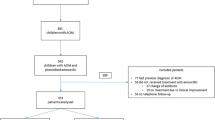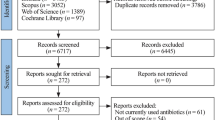Abstract
A total of 311 children who had recurrent otitis media or who had experienced failure of initial treatment of acute otitis media with phenoxymethylpenicillin, amoxicillin, ampicillin esters or cefaclor were entered into a single-blind study in two parallel groups in order to compare the clinical efficacy and safety of amoxicillin/clavulanate suspension given b.i.d. or t.i.d. for seven days. The patients were examined prior to the start of treatment, at an early follow-up visit 9 to 12 days after the start of treatment and at a late follow-up visit about three weeks later. Specimens for bacteriological culture were taken from the nasopharynx at entry, at the early follow-up visit, and at the late follow-up visit if there were symptoms of otitis. Both treatment groups showed a similar response, 90 % or more of the patients being cured or showing improvement at the time of the early follow-up visit. The initial nasopharyngeal cultures showed growth ofHaemophilus influenzae in 53 % of the patients,Moraxella catarrhalis in 43 % andStreptococcus pneumiae in 39 %. After treatment, cultures showed elimination of the initial pathogens in 30 % of patients in both groups and recolonization in 23 % in both groups.Haemophilus influenzae was the bacteria most frequently found in the nasopharynx at the first follow-up visit. Adverse effects, which consisted mostly of gastrointestinal and dermatological reactions, tended to be more common in the b.i.d. group but the difference was not statistically significant.
Similar content being viewed by others
References
Bluestone CD Augmentin therapy for acute otitis media in children. Summary of presentations from four clinical trials. Postgraduate Medicine 1984, 76: 137.
Jacobsson S, Rigner P, von Sydow C, Bondesson G Recurrent and penicillin V-resistant otitis media. Acta Otolaryngologica 1988, 106: 171–177.
Greenberg RN Overview of patient compliance with medication dosing: a literature review. Clinical Therapeutics 1984, 6: 592–599.
Pocock SJ Clinical trials. A practical approach. John Wiley, Chichester, 1983.
O'Callaghan CH, Morris A, Kirby SM, Shingler AH Novel method for detection of beta-lactamases by using a chromogenic cephalosporin substrate. Antimicrobial Agents and Chemotherapy 1972, 1: 282–288.
Kilian M, Biberstein EL GenusHaemophilus. In: Krieg NR, Holt JG (ed): Bergey's manual of systematic bacteriology. Volume 1. Williams & Wilkins, Baltimore, 1984, p. 558–569.
Lund E, Henrichsen J Laboratory diagnosis, serology and epidemiology ofStreptococcus pneumoniae: In: Bergan T, Norris JR (ed): Methods in microbiology. Academic Press, London, 1978, p. 241–262.
Stenström C, Lundgren K, Ingvarsson L, Bertilson SO Amoxicillin/clavulanate versus amoxicillin in recurrent otitis media and therapeutic failure in children. Acta Otolaryngologica 1991, 111: 120–129.
Kamme C, Lundgren K, Mårdh PA The aetiology of acute otitis media in children. Scandinavian Journal of Infectious Diseases 1971, 3: 217–223.
Suzuki K, Baba S, Inagaki M, Kabayashi T The antibiotic susceptibilities and beta-lactamase production of clinical isolatedBranhamella catarrhalis from acute otitis media in children. Auris Nasus Larynx 1988, 15: 105–111.
Ejlertsen T, Schönheyder H Infektioner medBranhamella catarrhalis. Ugeskrift for Laeger 1990, 152: 475–477.
Calder MA, Crougham MJ, McLeod DT, Ahmad F The incidence and antibiotic susceptibility ofBranhamella catarrhalis in respiratory infections. Drugs 1986, 31, Supplement 3: 11–16.
Philippon A, Riou JY, Guibourdenche M, Sotolongo F Detection, distribution and inhibition ofBranhamella catarrhalis beta-lactamases. Drugs 1986, 31, Supplement 3: 64–69.
Bluestone CD Otitis media and sinusitis in children. Drugs 1986, 31, Supplement 3: 132–141.
Mölstad S, Eliasson I, Hovelius B, Kamme C, Schalén C Beta-lactamase production in the upper respiratory tract flora in relation to antibiotic consumption: a study in children attending day nurseries. Scandinavian Journal of Infectious Diseases 1988, 20: 329–334.
Author information
Authors and Affiliations
Additional information
S.O. Bertilson, Södertälje, Sweden; P.Bjerrum, Randers, Denmark; O. Blevgad Andersen, Århus, Denmark; S.E.Böhme, Frederikshavn, Denmark; G. Englund, Stockholm, Sweden; A. Harbo, E. Hübertz Mortensen, Randers, Denmark; K. Juul Jensen, Århus, Denmark; B. Kortholm, Vejle, Denmark; S. Madsen, Hobro, Denmark; V. Moesgaard Nielsen, Ålborg, Denmark; M. Mortensen, Randers, Denmark; K. Pfeiffer Petersen, Albertslund, Denmark; P. Rigner, Göteborg, Sweden; A.S. Storm Hansen, Ålborg, Denmark; C. von Sydow, Göteborg, Sweden.
Rights and permissions
About this article
Cite this article
Jacobsson, S., Fogh, A., Larsson, P. et al. Evaluation of amoxicillin clavulanate twice daily versus thrice daily in the treatment of otitis media in children. Eur. J. Clin. Microbiol. Infect. Dis. 12, 319–324 (1993). https://doi.org/10.1007/BF01964426
Issue Date:
DOI: https://doi.org/10.1007/BF01964426




